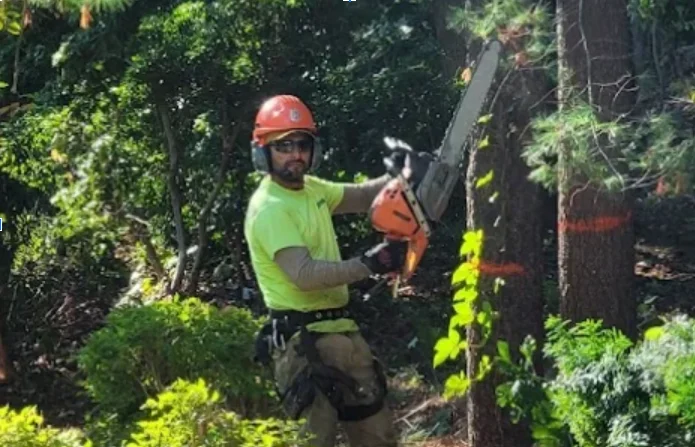Recognizing and Preventing Bad Tree Trimming
Bad tree trimming can cause serious, long-term damage to your trees. Understanding what constitutes improper pruning helps you avoid costly mistakes and protect your trees' health and value.
Warning Signs of Bad Tree Trimming
Watch for these red flags that indicate poor pruning practices:
1. Topping or Heading
Topping involves cutting tree branches back to stubs or removing large portions of the crown. This is one of the most harmful practices:
- Removes too much of the tree's canopy at once
- Stimulates weak, rapid regrowth
- Increases risk of branch failure
- Makes trees more susceptible to disease and pests
- Reduces tree lifespan significantly
2. Lion's Tailing
Lion's tailing removes interior branches, leaving only foliage at branch ends:
- Creates weak branch structure
- Increases wind damage risk
- Reduces tree's ability to produce energy
- Makes trees more prone to sunscald
3. Flush Cuts
Cutting branches flush with the trunk damages the branch collar:
- Removes the tree's natural defense zone
- Prevents proper wound closure
- Increases disease and decay risk
- Can lead to trunk decay
4. Stub Cuts
Leaving branch stubs instead of proper cuts:
- Prevents proper wound closure
- Attracts pests and disease
- Creates weak attachment points
- Leads to decay
5. Over-Pruning
Removing too much foliage at once:
- Removes more than 25% of canopy in a single season
- Stresses trees severely
- Reduces ability to produce energy
- Can kill trees, especially if repeated
6. Wrong Timing
Pruning at inappropriate times:
- Pruning during active growth can stress trees
- Pruning certain species at wrong times increases disease risk
- Pruning during extreme weather conditions
7. Using Wrong Tools
Improper equipment causes damage:
- Dull tools create ragged cuts
- Wrong tool size damages branches
- Unsanitized tools spread disease
- Chainsaws for small branches cause unnecessary damage
Consequences of Bad Tree Trimming
Improper pruning has serious consequences:
- Tree Decline: Weakened trees become more susceptible to disease, pests, and environmental stress
- Structural Weakness: Poor cuts create weak branch attachments that fail during storms
- Reduced Lifespan: Severely pruned trees may die prematurely
- Increased Maintenance: Bad pruning often requires more frequent, expensive corrections
- Property Damage: Weak branches can fall and damage property
- Decreased Property Value: Unhealthy, poorly maintained trees reduce curb appeal
Proper Tree Pruning Techniques
Professional arborists follow these best practices:
1. Natural Target Pruning
Making cuts just outside the branch collar and branch bark ridge preserves the tree's natural defense mechanisms.
2. Selective Branch Removal
Removing specific branches for clear reasons (dead, diseased, crossing, or hazardous) rather than indiscriminate cutting.
3. Appropriate Pruning Amounts
Never removing more than 25% of a tree's canopy in a single season, and often much less.
4. Proper Timing
Pruning during appropriate seasons for each tree species and avoiding times when trees are most vulnerable.
5. Using Right Tools
Sharp, clean, properly sized tools that make clean cuts without damaging surrounding tissue.
6. Crown Cleaning
Removing dead, dying, diseased, and broken branches to improve tree health.
7. Crown Thinning
Selective removal of branches to improve light penetration and air circulation without removing too much foliage.
How to Choose a Tree Service
Avoid bad tree trimming by choosing qualified professionals:
- Certified Arborists: Look for ISA (International Society of Arboriculture) certification
- Insurance: Verify the company has proper liability and workers' compensation insurance
- References: Ask for references and check online reviews
- Written Estimates: Get detailed, written estimates before work begins
- No Topping Guarantees: Avoid companies that recommend topping
- Professional Equipment: Proper tools and safety equipment
Red Flags to Avoid
Warning signs of unqualified tree services:
- Door-to-door solicitation after storms
- Pressure to make immediate decisions
- Unusually low prices (often indicates lack of insurance or qualifications)
- Recommendations to top trees
- No references or certifications
- Requests for full payment upfront
Correcting Bad Tree Trimming
If your tree has been improperly pruned:
- Assess Damage: Have a certified arborist evaluate the tree's condition
- Determine Recovery Potential: Some trees can recover with proper care
- Corrective Pruning: Professional pruning to improve structure and health
- Ongoing Care: Regular maintenance to support recovery
- Consider Removal: If damage is too severe, removal may be necessary
Professional Tree Pruning Services

At McDonald Tree Service, we provide professional tree pruning services throughout Billerica, Massachusetts, and surrounding areas. Our certified arborists:
- Follow industry best practices and ANSI A300 standards
- Use proper pruning techniques that promote tree health
- Make clean, precise cuts that allow proper wound closure
- Prune at appropriate times for each tree species
- Use sharp, sanitized, professional-grade equipment
- Never top trees or use harmful practices
- Provide ongoing maintenance to support tree health
Don't let bad tree trimming damage your valuable trees. Contact McDonald Tree Service for professional, certified tree care that protects your trees' health and your property's value.
